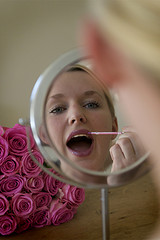Lipstick History
The history of lipstick dates back to 60BC, when Egyptian women, like Cleopatra applied lip color. In the 1700’s, the British Parliament passed a law that stated women wearing lip color could be tried for witchcraft, but by the 1800’s women wore it and red lip-stick meant you were a fast woman. By the 1920’s, red lip-stick meant power and Hollywood starlets increased the popularity of lip color. Elizabeth Arden made it accessible to the average women in the 1930’s and by 1949 a long lasting lip-stick was perfected by Hazel Bishop.
How Lip-stick is Made
How lipstick is made may seem disgusting to many, although there are natural lip-sticks being made. Over the years, red lip color has been made with carmine, which is derived by boiling highly pigmented beetles, to give it the crimson color. Other red lip-stick pigments, such as Red #40 are derived from coal tar, which is processed to produce a thin dye, which is considered safe. Phthalates are contained in three quarters of lip-sticks and of course, fragrances are added in most cases. Today, lip-sticks are made of wax, oil, alcohol and pigment. The wax is usually beeswax, candelilla wax or camauba. Mineral, castor, lanolin or vegetable oils are added to the wax then fragrance and pigment are added along with preservatives and antioxidants, to keep the lip-stick from spoiling. Other substances to make it smoother or glossier may be added as moisturizers.
Lip-stick has Captivating Colors
Colors of lipstick offer a wide range of reds, pinks, corrals, naturals, browns, purples, whites, silvers and any combination. Pink shades are made by mixing titanium dioxide with various shades of red, for example. Much like crayons, lip colors involve heating and mixing to get the desired color and texture. Colors have their own meanings.
Matte lip-sticks are heavier in wax, with more texture than shine, crème lip-sticks are balanced between shine and texture, glosses have high shine and low color. Sheers contain more oil than wax, and shimmers have extra glimmer added that comes from mica or silica particles.
Choosing the right color to match your complexion is important, so if you have lighter skin, choose a color that is brighter and avoid light pinks. Lighter shades of lipstick will make a fair complexion seem paler and dull, while accentuating a darker complexion. Try lip-stick colors with your own picture with this virtual makeover.
Mineral Ingredients
Ingredients found in lip-stick include minerals such as mica, iron oxides, titanium dioxide, tin oxide, silica, soy glycerides for glimmer or to mix to get pastels of dark shades, as given in the example above for pinks. They also have healing properties and antioxidant or sunscreen properties that come natural through mineral makeup. Many of the most natural lip color sticks contain these products.
Lipstick Antioxidants
Antioxidants used in lip-stick are commonly ascorbyl palmitate or tocopherol, (a form of vitamin E). Because of the alcohol contained in lip color sticks, extra things are added to make lips suppler. By adding antioxidants, sunscreen, and minerals for shimmer and color enhancers, lip-stick has become a much healthier skin care product in recent years.
Psychology In Lip Color sticks
Psychological reasons for wearing lip color stick today include reasons such as self-esteem and confidence rather than as sexual allurement purposes, as in years past. Behaviorists believed that wearing lip-stick originated with claims that the lips remind us of the labia, because they flush red and swell when aroused, which is the conscious and unconscious reason women have always made them look redder with lip color stick. Now, it is still believed that it is a method meant to attract attention to the face and detract it from the rear.
However, most women now claim they wear it to feel prettier and feel better about themselves. Because studies have shown that society places more value on beautiful people, who tend to have better careers, higher social status and earn more money, cosmetic companies have capitalized on this ultimate goal, which is the real reason it is believed that women love to wear lip-stick. When it comes to reasons women purchase lip-stick, the most popular reasons were they “wanted a change” or they were replacing an existing tube.
Mineral Lipstick Application
The best way to apply lipstick is to use a lip-stick brush. Prepare the lips by smoothing them with foundation using a makeup sponge. Dust over the top of them with a light dusting of facial powder to make the lip color stick stay longer. Use a lip-stick brush to brush over the surface to get into every fine line, and open your mouth to get into the corners. Blot the surface with a tissue, which gives you a semi-matte finish. You can repeat the process for a longer lasting finish. Of course you can always apply it the easy way from a tube. Is there any reason why you wouldn't want to treat yourself to new lip-stick here?
back to the top of lipstick page
from lipstick to mineral makeup application page
Don't just build a website, build a web business!
Beauty is just a click away! Visit me, your Independent Beauty Consultant.
Welcome to The Essence of Mineral Makeup website!!! A site for makeup and mineral healing information.
For your convenience, Shop 24 hours a day! Visit me, your Mary Kay Independent Beauty Consultant: www.marykay.com/sandycarosi
Compliments of this website!!!









